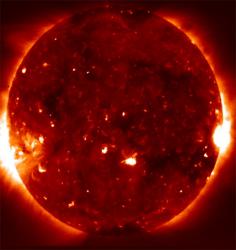The Japanese sun-observing satellite Hinoda managed to produce some spectacular images of the sun as part of its testing phase.
 The Japanese satellite Hinoda, which studies the sun, flies in a polar sun-synchronous orbit that allows its instruments to remain in sunlight for nine months of the year. Hinoda is equipped with three of them: an optical solar telescope, an X-ray telescope, and an imaging spectrometer in the extreme ultraviolet range.
The Japanese satellite Hinoda, which studies the sun, flies in a polar sun-synchronous orbit that allows its instruments to remain in sunlight for nine months of the year. Hinoda is equipped with three of them: an optical solar telescope, an X-ray telescope, and an imaging spectrometer in the extreme ultraviolet range.
The optical telescope allows the spacecraft to see magnified images of the Sun's surface. These photographs make it possible to reveal heat flows in the sun (convections), in which the gas rises and falls in the photosphere. The device will also enable detection and measurement of the strength and direction of the sun's magnetic field.
The X-ray telescope will reveal the Sun's corona, its outer atmosphere. This is the area that emits the massive coronal emissions, which can send materials towards the Earth, which can interfere with communication and create the beautiful aurora borealis.
The last device is of course the extreme ultraviolet imaging spectrometer. This gadget measures the speed of solar material and allows astronomers to measure the temperature and density of the sun's outer atmosphere.
At the end of December, the Hinoda spacecraft began regular observations after the scientists finished calibrating its instruments.
For the news in Universe Today
Hinoda photographed the transit of the star Hema around the Sun

2 תגובות
The picture is very beautiful, are there more pictures?
Photos that the sun shines the most beautiful from an observatory